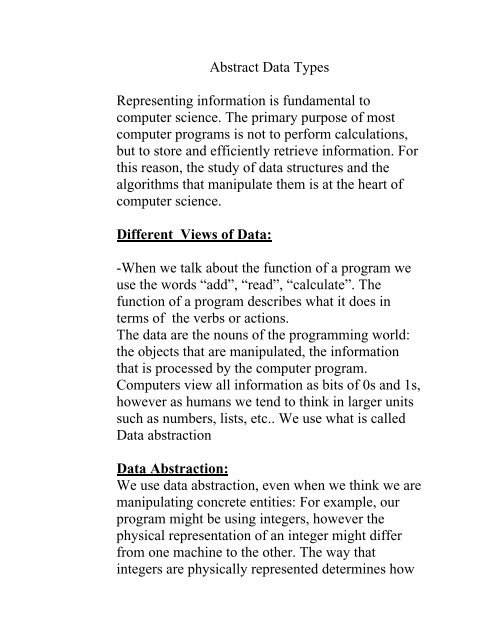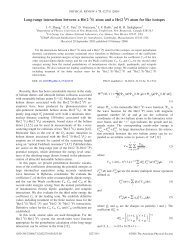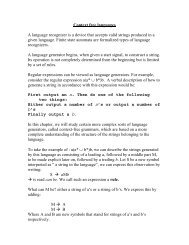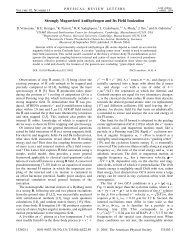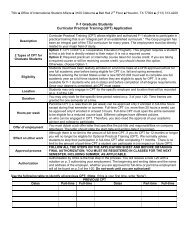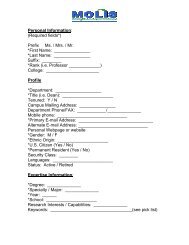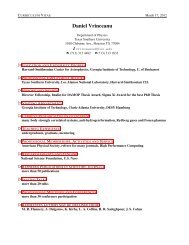Introduction to - Department of Computer Science
Introduction to - Department of Computer Science
Introduction to - Department of Computer Science
You also want an ePaper? Increase the reach of your titles
YUMPU automatically turns print PDFs into web optimized ePapers that Google loves.
Abstract Data Types<br />
Representing information is fundamental <strong>to</strong><br />
computer science. The primary purpose <strong>of</strong> most<br />
computer programs is not <strong>to</strong> perform calculations,<br />
but <strong>to</strong> s<strong>to</strong>re and efficiently retrieve information. For<br />
this reason, the study <strong>of</strong> data structures and the<br />
algorithms that manipulate them is at the heart <strong>of</strong><br />
computer science.<br />
Different Views <strong>of</strong> Data:<br />
-When we talk about the function <strong>of</strong> a program we<br />
use the words “add”, “read”, “calculate”. The<br />
function <strong>of</strong> a program describes what it does in<br />
terms <strong>of</strong> the verbs or actions.<br />
The data are the nouns <strong>of</strong> the programming world:<br />
the objects that are manipulated, the information<br />
that is processed by the computer program.<br />
<strong>Computer</strong>s view all information as bits <strong>of</strong> 0s and 1s,<br />
however as humans we tend <strong>to</strong> think in larger units<br />
such as numbers, lists, etc.. We use what is called<br />
Data abstraction<br />
Data Abstraction:<br />
We use data abstraction, even when we think we are<br />
manipulating concrete entities: For example, our<br />
program might be using integers, however the<br />
physical representation <strong>of</strong> an integer might differ<br />
from one machine <strong>to</strong> the other. The way that<br />
integers are physically represented determines how
the computer manipulates them. However as<br />
programmers, we rarely get involved at this level.<br />
Binary : 10011001<br />
Decimal: 153 (unsigned), -25 (sign and magnitude)<br />
-102 (one’s complement), -103 (two’s<br />
complement)…<br />
Data Encapsulation:<br />
Data encapsulation means that the physical<br />
representation <strong>of</strong> a program’s data is surrounded.<br />
The user <strong>of</strong> the data does not see, nor usually cares<br />
about the implementation, but deals with the data<br />
only in its logical picture- its abstraction.<br />
To make encapsulation effective, operations must<br />
be provided <strong>to</strong> allow the user <strong>to</strong> create, access and<br />
change data. For example for the data type int, C++<br />
provides ways <strong>to</strong> create variables <strong>of</strong> this data type<br />
by using declarations; we can assign values <strong>to</strong> them<br />
using the assignment opera<strong>to</strong>r, we can perform<br />
arithmetic operations using +, - *,….<br />
Abstract Data Type and Data structures:<br />
A type is a collection <strong>of</strong> values. For example the<br />
Boolean type consists <strong>of</strong> the values true and false.<br />
The integers also form a type.<br />
An integer is a simple type because its values<br />
contain no subparts.<br />
A bank account record will typically contain several<br />
pieces <strong>of</strong> information such as name, address,
account number, and an account balance. Such a<br />
record is an example <strong>of</strong> an aggregate type or<br />
composite type.<br />
A data type is a type <strong>to</strong>gether with a collection <strong>of</strong><br />
operations <strong>to</strong> manipulate the type.<br />
An abstract data type (ADT)<br />
A data type whose properties are specified<br />
independently <strong>of</strong> any particular implementation. An<br />
abstract data type describes the logical properties <strong>of</strong><br />
the data type. The interface <strong>of</strong> the ADT is defined in<br />
terms <strong>of</strong> a type and a set <strong>of</strong> operations on that type.<br />
The behavior <strong>of</strong> each operation is determined by its<br />
inputs and outputs. An ADT does not specify how<br />
the data type is implemented, these details are<br />
hidden from the user <strong>of</strong> the ADT and protected<br />
from outside access by encapsulation..<br />
Data encapsulation:<br />
The separation <strong>of</strong> the representation <strong>of</strong> data from<br />
the applications that use the data at a logical level.<br />
A data structure is the concrete implementation <strong>of</strong><br />
an ADT.<br />
Data structures are usually aggregate types; they<br />
can be decomposed in<strong>to</strong> their component elements.<br />
The arrangement <strong>of</strong> these components is a feature <strong>of</strong><br />
the structure that effects how each element can be<br />
accessed.<br />
Both the arrangement <strong>of</strong> the elements and the way<br />
they are accessed can be encapsulated.
Example: a library<br />
A library can be decomposed in<strong>to</strong> its component<br />
elements : books.<br />
The collection <strong>of</strong> individual books can be arranged<br />
in a number <strong>of</strong> ways. However the user need not<br />
know the system in order <strong>to</strong> locate a book, because<br />
the librarian or the direc<strong>to</strong>ry can point him/her <strong>to</strong><br />
the book they want.<br />
We use the same approach <strong>to</strong> data structures: A data<br />
structure is defined by 1) the logical arrangement <strong>of</strong><br />
data elements combined with (2) the set <strong>of</strong><br />
operations we need <strong>to</strong> access the elements.<br />
Abstract Data Types Opera<strong>to</strong>r Categories:<br />
Four basic operations are performed on an abstract<br />
data type: construc<strong>to</strong>rs, transformers, observers, and<br />
itera<strong>to</strong>rs.<br />
A construc<strong>to</strong>r is an operation that creates a new<br />
instance (object) <strong>of</strong> an ADT. It is invoked at the<br />
language level by some sort <strong>of</strong> declaration.<br />
Transformers are operations that change the state <strong>of</strong><br />
one or more <strong>of</strong> the data values, such as inserting an<br />
item in<strong>to</strong> an object, deleting an item from an<br />
object…<br />
An observer is an operation that allows us <strong>to</strong><br />
observe the state <strong>of</strong> one or more <strong>of</strong> the data values
without changing them. These include predicates<br />
checking if a certain property is true, accessor or<br />
selec<strong>to</strong>r functions that return a copy <strong>of</strong> an item …<br />
An itera<strong>to</strong>r is an operation that allow us <strong>to</strong> process<br />
all components in a data structure sequentially.<br />
Composite Data Types<br />
C++ provides three types <strong>of</strong> composite data types: records<br />
(struct), classes and arrays with various dimensions.<br />
Classes and structs can have member functions as well as<br />
data. Classes and structs are logically unstructured.<br />
Records:<br />
In C++, records are implemented by structs. C++ classes<br />
are another implementation <strong>of</strong> a record.<br />
Logical Level: A record is a composite type made up <strong>of</strong> a<br />
finite collection <strong>of</strong> not necessarily homogeneous elements<br />
called members or fields. Accessing is done directly<br />
through a set <strong>of</strong> named member or field selec<strong>to</strong>rs.<br />
struct CarType<br />
{ int year;<br />
char maker[10];<br />
float price;<br />
};<br />
CarType myCar;
The record variable myCar is made up <strong>of</strong> 3 components.<br />
The first, year is <strong>of</strong> type int. The second, maker, is an<br />
array <strong>of</strong> characters. The third, price, is a float number.<br />
The name <strong>of</strong> the components make up the set <strong>of</strong> member<br />
selec<strong>to</strong>rs.<br />
The syntax <strong>of</strong> the component selec<strong>to</strong>r is the record<br />
variable name, followed by a period, followed by member<br />
selec<strong>to</strong>r. myCar.price<br />
Higher-Level Abstraction and the C++ Class<br />
Type<br />
When we design an ADT, we want <strong>to</strong> bind the operations<br />
<strong>of</strong> the data type with the data that are being manipulated.<br />
The Class Type is the perfect mechanism for doing that.<br />
The class type is a construct in which the members <strong>of</strong> the<br />
class can be both functions and data. A class encapsulates<br />
a fixed number <strong>of</strong> data components with the functions<br />
that manipulate them; the predefined operations on an<br />
instance <strong>of</strong> a class are whole assignment and component<br />
access.<br />
In an object-oriented language, such as C++, an ADT and<br />
its implementation <strong>to</strong>gether make up a class.<br />
Each operation associated with the ADT is implemented<br />
by a member function.<br />
The variables that define the space required by a data item<br />
are referred <strong>to</strong> as data members.<br />
An object is an instance <strong>of</strong> a class, that is, something that<br />
is created and takes up s<strong>to</strong>rage during the execution <strong>of</strong> a<br />
computer program.
Classes are written in two parts, the specification and the<br />
implementation.<br />
The specifications include data and operations on the<br />
data.<br />
The implementation section fully defines the operations<br />
and provides the manner in which these data can be<br />
manipulated.<br />
Class Specification:<br />
Although the class specification and implementation<br />
could reside in the same file, the two parts <strong>of</strong> a class are<br />
usually separated in<strong>to</strong> two files.<br />
The specification goes in<strong>to</strong> a header file(.h extension) and<br />
the implementation goes in<strong>to</strong> a file with the same name<br />
but with a .cpp extension.<br />
//Declares a class <strong>to</strong> represent the Date ADT.<br />
//This is file DateType.h<br />
class DateType<br />
{<br />
public:<br />
void Initialize(int newMonth, int newDay, int<br />
newYear);<br />
int GetYear() const;<br />
int GetMonth() const;<br />
int GetDay() const;<br />
private:<br />
int year;<br />
int month;
};<br />
int day;<br />
The member functions <strong>of</strong> the class are Initialize, GetYear,<br />
GetMonth, GetDay. They are marked public, which<br />
means that outside code (client) can access these<br />
functions.<br />
Initialize is a construc<strong>to</strong>r operation: it takes values for the<br />
year, month and day and s<strong>to</strong>res these values in<strong>to</strong> the<br />
appropriate data members <strong>of</strong> an instance <strong>of</strong> the class or an<br />
object.<br />
GetYear, GetMonth and GetDay are accessor functions,<br />
they access data members <strong>of</strong> the class. The const beside<br />
accessor function names guarantees that these functions<br />
do not change any <strong>of</strong> the data members <strong>of</strong> the objects <strong>to</strong><br />
which they apply.<br />
Class Implementation<br />
Only member functions <strong>of</strong> the class DateType can access<br />
the data members. so we must associate the class name<br />
with the function definitions. We do so by inserting the<br />
class name before the function name, separated by the<br />
scope resolution opera<strong>to</strong>r(::)<br />
The implementation <strong>of</strong> the member functions goes in<strong>to</strong><br />
the file DateType.cpp.<br />
To access the specifications, we must insert the file<br />
DateType.h by using an #include directive<br />
//Define member functions <strong>of</strong> class DateType
This is the file DateType.cpp<br />
#include “DateType.h” //Gain access <strong>to</strong> the specification<br />
<strong>of</strong> the class<br />
void DateType::Initialize (int newMonth, int newDay, int<br />
newYear)<br />
{<br />
year= newYear;<br />
month= newMonth;<br />
day= newDay;<br />
}<br />
int DateType::GetMonth() const<br />
{<br />
return month;<br />
}<br />
int DateType::GetDay() const<br />
{<br />
return day;<br />
}<br />
int DateType::GetYear() const<br />
{<br />
return year;<br />
}<br />
A client <strong>of</strong> the class DateType must have an #include<br />
“DateType.h” directive for the specification (header) file<br />
<strong>of</strong> the class.<br />
Note: System-supplied header files are enclosed in anglebrackets,<br />
whereas user defined header files are enclosed<br />
in double quotes.
The client then declares a variable <strong>of</strong> type DateType just<br />
as it would any other variable.<br />
#include <br />
#include “DateType.h”<br />
using namespace std;<br />
DateType <strong>to</strong>day;<br />
DateType anotherDay;<br />
<strong>to</strong>day. Initialize(9, 5, 2007);<br />
anotherDay.Initialize(9, 25, 2007);<br />
cout
RelationType ComparedTo(DateType someDate);<br />
//Compares self with someDate<br />
To determine which date comes first, we must compare<br />
the year members <strong>of</strong> the instance and the parameter. If<br />
they are the same, we must compare the month members.<br />
If the year members and the month members are the<br />
same, we must compare the day members. To access the<br />
fields <strong>of</strong> the instance, we just use their names. To access<br />
the fields <strong>of</strong> the parameter, we prefix the field name with<br />
the parameter name and a dot.<br />
RelationType DateType::ComparedTo(DateType aDate)<br />
{<br />
}<br />
if (year aDate.year)<br />
return GREATER;<br />
else if (month aDate.month)<br />
return GREATER;<br />
else if (day < aDate.day)<br />
return LESS;<br />
else if (day >aDate.day)<br />
return GREATER<br />
else return EQUAL;
In this code, the year refers <strong>to</strong> the year data member <strong>of</strong><br />
the object <strong>to</strong> which the function is applied; aDate.year<br />
refers <strong>to</strong> the data member <strong>of</strong> the object passed as a<br />
parameter.<br />
The object <strong>to</strong> which the a member function is applied is<br />
called self. In the function definition, the data members <strong>of</strong><br />
self are referenced directly without using the dot notation.<br />
switch (<strong>to</strong>day.ComparedTo(anotherDay))<br />
{<br />
case LESS : cout


